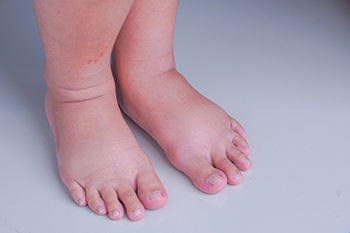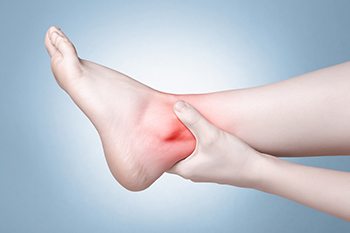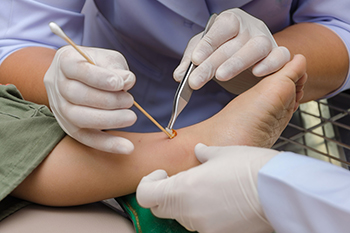Connect With Us
Blog
Items filtered by date: January 2023
Your Feet Should Swell Together

When feet become swollen, it most likely will affect both of them. One swollen foot may be cause for alarm, and it is advised that prompt medical attention is obtained from a podiatrist. One swollen foot may indicate an allergy or infection, possibly causing serious complications if not treated. When both feet are swollen, it is a common condition and can happen for various reasons. These can include water retention from circulatory issues, pregnancy, or premenstrual disorders. Swollen feet may be improved by following a gentle exercise regime and drinking plenty of water. Additionally, having regular massages and reducing sodium intake may help to alleviate swollen ankles. If you suffer from this condition, it is advised that you consult with a podiatrist who can determine what the cause is and offer correct treatment options.
Swollen feet can be a sign of an underlying condition. If you have any concerns, contact Imaze Marian Davis, DPM of Marian Davis, DPM, PA. Our doctors can provide the care you need to keep you pain-free and on your feet.
Swollen feet are a common ailment among pregnant women and people who stand or sit for extended periods. Aging may increase the possibility of swollen feet and patients who are obese often notice when their feet are swelling too. There may be medical reasons why swollen feet occur:
- Phlebitis - A condition that causes the veins to become inflamed and can also cause leg pain.
- Liver disease - This may lead to low blood levels of albumin which is a protein. This can cause fluid in the blood to pass into the tissues and several areas of the body can become swollen.
- Heart failure - When the heart doesn’t pump properly the blood that is normally pumped back to the heart can pool in the veins of the legs causing swollen feet.
- Kidney disease - One of the main functions of the kidneys is releasing excess fluid in the body. This type of condition can make it difficult for the kidneys to function properly, and as a result the feet may become swollen.
- Deep-vein thrombosis (DVT)- This is a serious condition where blood clots form in the veins of the legs. They can block the return of blood from the legs to the heart which may cause the feet to swell. It is important to be treated by a podiatrist if this condition is present.
Swollen feet can also be caused by bone and tendon conditions, including fractures, arthritis, and tendinitis. Additionally, there may be skin and toenail conditions and an infection may cause the feet to swell. Patients who take medicine to treat high blood pressure may be prone to getting swollen feet.
Many patients elevate their feet to help relieve the swelling and this is generally a temporary remedy. When a podiatrist is consulted the reason behind the swelling can be uncovered and subsequently treated.
If you have any questions please feel free to contact our office located in Miami, FL . We offer the newest diagnostic tools and technology to treat your foot and ankle needs.
Common Causes of Ankle Pain

Ankle pain, whether it is caused by a sprain, fracture, or inflammation, can affect your ability to carry out daily activities. If you are unable to put weight on your ankle, it’s a good idea to seek immediate medical help. The number one cause of ankle pain is a sprain, most commonly in the ligament on the outside of the ankle. This is caused when the foot rolls inward, forcing the outside of the ankle to stretch beyond its normal range. A sprained ankle can be caused by stepping off the curb and landing incorrectly on your foot or during a sports or running injury. Rheumatoid arthritis is another major cause of ankle pain. This type of arthritis attacks the lining of the joints and results in painful inflammation. Osteoarthritis also causes ankle pain. In this form of arthritis, the cartilage between the bones deteriorates, causing extreme pain as the bones rub against each other. It more commonly affects people over 65 years old. Flat feet, ankle fractures, and Achilles tendonitis are other causes of ankle pain. Treatment for ankle pain depends on cause and severity. It is a good idea to consult a podiatrist as soon as possible for an examination and a diagnosis. The podiatrist can then determine the proper treatment options for you.
Ankle pain can have many different causes and the pain may potentially be serious. If you have ankle pain, consult with Imaze Marian Davis, DPM from Marian Davis, DPM, PA. Our doctors will assess your condition and provide you with quality foot and ankle treatment.
Ankle pain is any condition that causes pain in the ankle. Due to the fact that the ankle consists of tendons, muscles, bones, and ligaments, ankle pain can come from a number of different conditions.
Causes
The most common causes of ankle pain include:
- Types of arthritis (rheumatoid, osteoarthritis, and gout)
- Ankle sprains
- Broken ankles
- Achilles tendinitis
- Achilles tendon rupture
- Stress fractures
- Tarsal tunnel syndrome
- Plantar fasciitis
Symptoms
Symptoms of ankle injury vary based upon the condition. Pain may include general pain and discomfort, swelling, aching, redness, bruising, burning or stabbing sensations, and/or loss of sensation.
Diagnosis
Due to the wide variety of potential causes of ankle pain, podiatrists will utilize a number of different methods to properly diagnose ankle pain. This can include asking for personal and family medical histories and of any recent injuries. Further diagnosis may include sensation tests, a physical examination, and potentially x-rays or other imaging tests.
Treatment
Just as the range of causes varies widely, so do treatments. Some more common treatments are rest, ice packs, keeping pressure off the foot, orthotics and braces, medication for inflammation and pain, and surgery.
If you have any questions, please feel free to contact our office located in Miami, FL . We offer the newest diagnostic and treatment technologies for all your foot care needs.
Approximate Recovery Time for Bunion Surgery

A bunion is defined as a bony protrusion that is found on the side of the big toe, which may shift toward the other toes as it becomes larger. Corns may form on the side of the bunion from rubbing against the shoe, and this is often uncomfortable. Patients may choose to have bunion surgery, which is generally successful in removing the bunion, and straightening the big toe. A cast is often worn that can stabilize the foot, and existing pain and swelling will gradually diminish in approximately six weeks. Research has shown that adequate rest may accelerate healing, and many people choose to take time off from work. The foot may become stronger when specific exercises are performed, in addition to improving flexibility and range of motion. If you have a bunion and are considering surgery for permanent removal, please consult with a podiatrist who can determine if this is correct for you.
Foot surgery is sometimes necessary to treat a foot ailment. To learn more, contact Imaze Marian Davis, DPM of Marian Davis, DPM, PA. Our doctors will assist you with all of your foot and ankle needs.
When Is Surgery Necessary?
Foot and ankle surgery is generally reserved for cases in which less invasive, conservative procedures have failed to alleviate the problem. Some of the cases in which surgery may be necessary include:
- Removing foot deformities like bunions and bone spurs
- Severe arthritis that has caused bone issues
- Cosmetic reconstruction
What Types of Surgery Are There?
The type of surgery you receive will depend on the nature of the problem you have. Some of the possible surgeries include:
- Bunionectomy for painful bunions
- Surgical fusion for realignment of bones
- Neuropathy decompression surgery to treat nerve damage
Benefits of Surgery
Although surgery is usually a last resort, it can provide more complete pain relief compared to non-surgical methods and may allow you to finally resume full activity.
Surgical techniques have also become increasingly sophisticated. Techniques like endoscopic surgery allow for smaller incisions and faster recovery times.
If you have any questions please feel free to contact our office located in Miami, FL . We offer the newest diagnostic and treatment technologies for all your foot and ankle needs.
The Three Foot Shapes

Babies' feet grow rapidly in their early years. An infant’s foot has 22 bones, and the remaining bones will form by the time the child reaches age five. Prior to this, babies’ feet are made of soft cartilage, and it is important that their first shoe is made of pliable materials. It is beneficial to have your child crawl and walk barefoot while indoors, and this is beneficial in keeping the foot strong. When your child is two years old, they will have a distinctive foot shape, either tapered, square, or round. These shapes are easy to notice, as the toes will be in a square formation when they are all the same length. Many patients’ second or third toe is the longest, and this is characteristic of the rounded shape. When the biggest toe is the longest, this generally falls into the tapered shape category. There are many things to know about children’s foot health, and if you would like additional information, please consult with a podiatrist.
The health of a child’s feet is vital to their overall well-being. If you have any questions regarding foot health, contact Imaze Marian Davis, DPM of Marian Davis, DPM, PA. Our doctors can provide the care you need to keep you pain-free and on your feet.
Tips for Keeping Children's Feet Healthy
- Make sure their shoes fit properly
- Look for any signs of in-toeing or out-toeing
- Check to see if they have Clubfoot (condition that affects your child’s foot and ankle, twisting the heel and toes inward) which is one of the most common nonmajor birth defects.
- Lightly cover your baby’s feet (Tight covers may keep your baby from moving their feet freely, and could prevent normal development)
- Allow your toddler to go shoeless (Shoes can be restricting for a young child’s foot)
- Cut toenails straight across to avoid ingrown toenails
- Keep your child’s foot clean and dry
- Cover cuts and scrapes. Wash any scratches with soap and water and cover them with a bandage until they’ve healed.
If you have any questions, please feel free to contact our office located in Miami, FL . We offer the newest diagnostic and treatment technologies for all your foot care needs.
Cleaning Foot Wounds

Wounds on the feet can develop for any number of different reasons. Commonly, if an individual is walking barefoot and steps on an irregular, sharp, or small object, this may create some kind of wound. Relatedly, foot wounds are common to some diabetics because the loss of feeling in the feet among diabetics makes it more difficult to even notice wounds when they develop. Although wound care is particular to each patient, several general rules of thumb might be useful. Generally, it might be a good idea to clean the wound before dressing it. If a medical professional says that it is permissible to do so, clean the wound with soap and water to fight against infections. It is also important to remember that the wound can also sometimes be dried with a towel so that it is not wet. Having a wet wound that makes the bandage wet might have a host of complications. If you are prone to developing foot wounds (perhaps because you suffer from diabetes or because you frequently walk around barefoot), contact a podiatrist today to see what you can do to ward off foot wounds.
Wound care is an important part in dealing with diabetes. If you have diabetes and a foot wound or would like more information about wound care for diabetics, consult with Imaze Marian Davis, DPM from Marian Davis, DPM, PA. Our doctors will assess your condition and provide you with quality foot and ankle treatment.
What Is Wound Care?
Wound care is the practice of taking proper care of a wound. This can range from the smallest to the largest of wounds. While everyone can benefit from proper wound care, it is much more important for diabetics. Diabetics often suffer from poor blood circulation which causes wounds to heal much slower than they would in a non-diabetic.
What Is the Importance of Wound Care?
While it may not seem apparent with small ulcers on the foot, for diabetics, any size ulcer can become infected. Diabetics often also suffer from neuropathy, or nerve loss. This means they might not even feel when they have an ulcer on their foot. If the wound becomes severely infected, amputation may be necessary. Therefore, it is of the upmost importance to properly care for any and all foot wounds.
How to Care for Wounds
The best way to care for foot wounds is to prevent them. For diabetics, this means daily inspections of the feet for any signs of abnormalities or ulcers. It is also recommended to see a podiatrist several times a year for a foot inspection. If you do have an ulcer, run the wound under water to clear dirt from the wound; then apply antibiotic ointment to the wound and cover with a bandage. Bandages should be changed daily and keeping pressure off the wound is smart. It is advised to see a podiatrist, who can keep an eye on it.
If you have any questions, please feel free to contact our office located in Miami, FL . We offer the newest diagnostic and treatment technologies for all your foot care needs.


